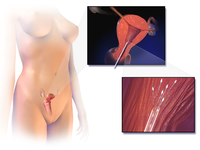
Photo from wikipedia
The reproductive performance of dairy herds is a determinant factor in their production efficiency and long-term profitability. While the genetic improvement of fertility in cows has been a top breeding… Click to show full abstract
The reproductive performance of dairy herds is a determinant factor in their production efficiency and long-term profitability. While the genetic improvement of fertility in cows has been a top breeding objective, its success has been constrained by the low heritability of current traits and the negative impact of management practices on trait measurement accuracy. The recent development and adoption of automated sensor technologies, such as activity monitors, within dairy production systems have provided new opportunities to identify relevant and cost-effective phenotypes of fertility. To date, several activity-based measurements of estrus expression have been associated with fertility outcomes and may, therefore, be suitable predictors of female fertility. The objective of this study was to identify and evaluate novel estrus-related fertility traits using automated activity monitor (AAM) data from commercial dairy herds. A total of 8,730,987 records consisting of 10,529 estrus events were collected between January 2019 and March 2020 from 2,434 cows and 689 heifers of two U.S. commercial herds, where cows were fitted with collar-mounted accelerometers (Heatime, SCR Engineers Ltd., Netanya, Israel). The AAM dataset contained individual bi-hourly activity and rumination patterns, as well as computed fertility index scores, which were used to derive fertility traits related to estrus duration and intensity. The mean number of estrus events per cow and heifer was 4.06 ± 0.04 and 2.63 ± 0.07, respectively, with 1,408 of estruses resulting in pregnancy. Traditional fertility traits were calculated from the breeding record information of 3,255 animals. An estimation of the heritabilities along with genetic and phenotypic correlations between the novel estrus-related fertility traits and traditional fertility traits was undertaken using the program AIREML. Outputs from this project are expected to provide further insight on how to best use AAM measurements to improve selection for reproductive performance in commercial dairy herds.
Journal Title: Journal of Animal Science
Year Published: 2020
Link to full text (if available)
Share on Social Media: Sign Up to like & get
recommendations!